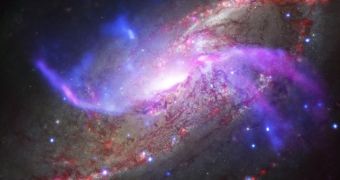Just in time for this year's July 4, which marks the anniversary of the adoption of the Declaration of Independence in the United States, astronomers announced that impressive cosmic fireworks were taking place in a nearby galaxy.
As detailed by researchers working with NASA (the National Aeronautics and Space Administration in the United States), the galaxy that is now busy putting on quite a show is dubbed Messier 106.
This galaxy sits about 23 million light-years from Earth, and the cosmic fireworks spectacle was documented with the help of NASA's Spitzer Space Telescope, the Chandra X-ray Observatory, and the Hershel Space Observatory.
The ongoing show in Messier 106 is caused by energetic jets stemming from the black hole located at the center of this spiral galaxy, and astronomers expect it to forever alter the galaxy's makeup and appearance, Phys Org informs.
According to astronomers who have taken the time to research this phenomenon, the energetic jets blasting from Messier 106's central black hole are not only heating up material in the spiral galaxy, but are also chasing away gases lurking in its interior.
In a paper, astronomers explain that, when heated up by the energetic jets, material in Messier 106 begins to glow, thus birthing the so-called cosmic fireworks observed by the Spitzer Space Telescope, the Chandra X-ray Observatory, and the Hershel Space Observatory.
As frightfully impressive as these cosmic fireworks might be, researchers say that they are not the ones that will forever transform Messier 106. On the contrary, it is the driving out of gases that stands to alter the appearance of this spiral galaxy.
This is because, as shown by previous investigations, the gases that the energetic jets are pushing away from Messier 106's interior are those that birth new stars. Hence, it is to be expected that, once these gases are gone, the galaxy's career as a stellar nursery will crash and burn.
“Jets from the supermassive black hole at the center of Messier 106 are having a profound influence on the available gas for making stars in this galaxy,” says Patrick Ogle, an astrophysicist at the Infrared Processing and Analysis Center at the California Institute of Technology in Pasadena.
“This process may eventually transform the spiral galaxy Messier 106 into a lenticular galaxy [a flat disk-like galaxy that lacks prominent spiral arms], depriving it of the raw material to form stars,” the researcher goes on to explain.
It is estimated that, until now, the black hole at the center of Messier 106 has managed to warm and chase away roughly two-thirds of the gas at the interior of this spiral galaxy. Thus, Messier 106 appears to already be transitioning towards a lenticular galaxy.

 14 DAY TRIAL //
14 DAY TRIAL //